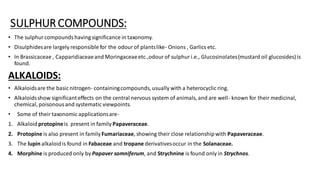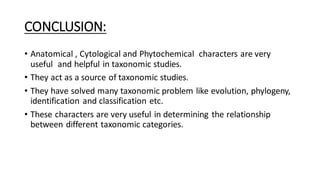Sources of Taxonomic Characters (Anatomy, Cytology, Phytochemistry)
- 1. SOURCES OF TAXONOMIC CHARACTERS – ANATOMY, CYTOLOGY & PHYTOCHEMISTRY Presentationby: Jyotishma Yesmin Submitted to: Dr Prantik Sharma Baruah Department of Botany Nowgong College(Autonomous)
- 2. INTRODUCTION: • Plant Taxonomy is the branch of science which deals with the identification, nomenclature and classification of plants. • Sources of Taxonomic characters like Morphology, Anatomy ,Cytology, Phytochemistry etc., of the plants have provided the foundation and framework for Taxonomy. • These characters have been used extensively in the preparation of classification systems, diagnostic keys,etc. • Plant anatomy, Cytology, Palynology,Physiology, Embryology, Phytochemistry etc.,have played a significant role in plant taxonomy.
- 3. ANATOMY: • The anatomical charactersare very useful in determining the relationshipbetween different taxonomic categories. Anatomicaldatahave also solved several phylogeneticproblems. • According to Redford (1968) some of the basic evidentiaryanatomicalcharactersof well - established taxonomic value are the type , size, shape and patternof wood cells ,stelar patterns,types of vascularbundles, rays, epidermal tissue,stomata,trichomes, sclereids, nodes etc. • Some anatomicalcharacterswith their role in taxonomy are - A.VEGETATIVE ANATOMY: EPIDERMIS: • Shape, size, wall thickness, inclusions,etc., of epidermal cells are some of the epidermal charactersof taxonomic importance in different families,genera,and species. • In Poaceae, Papillateepidermal cells are present ; presence and distributionof silica bodies in Cyperaceae, sclerificationof wall of the epidermal cells in some genera of Asteraceae, etc. are some of the characters useful in taxonomic importance. • Baruah and Nath (2002) and Baruah et.al.(2003) formulated a taxonomic key and established a phylogenetic affinity of the Northeast Indianmembers of Cinnamomum on the basis of foliar epidermal characters.
- 4. STOMATA: • The morphology and development of different stomataltypes are helpful to provide clues to various evolutionary trends among families of angiosperms and also helpful in assigning taxaof uncertain affinities to proper positions. • In Gymnosperms,Haplochelicand Syndetocheilic types of stomata are found. • In Dicot Angiosperms , Anomocytic or Rannunculaceous , Anisocytic or Cruciferous, Paracytic or Rubiaceous and Diacytic or Caryophyllaceous type of stomataare found. • In Monocot Angiosperms, equal size subsidiary stomata(Rhoeo), two lateral and two polar subsidiary stomata(Commelina) , paracytic stomata(manymonocot) and dumb- bell shaped guard(Poaceae) cell stomataare found. TRICHOMES: • Trichomes are epidermalhairs of much taxonomic value because they exhibitgreat diversityof form, size, structure and function. • Certain species of Vernonia , family Fabaceae and Icacinaceaeare differentiatedon the basis of their trichome characters. PETIOLE ANATOMY: • According to Howard(1963) families, genera and even species may be identified with the help of petiole anatomicalcharacters. • Petiolarvascularizationhasalso been helpfulin the classificationof Rhododendronand some genera.
- 5. LEAF ANATOMY: • Leaf anatomyprovides various characters of taxonomic value. • Characters of taxonomic significancein leaf anatomyinclude- nature and thickness of epidermis, mesophylltypes ,pattern of sclerenchyma, venationpattern ,crystals,etc. • Benson (1962) in Ranunculus, Webster(1967) in Euphorbia, Baruah and co – worker(1998,2002) in Vanilla have used several characters of leaf anatomyin differentiating species. SCLEREIDS: • Sclereides are the cells with very thick lignified walls. • They havebeen used as the diagnostictools in several taxa. • They are extremely rare in monocots (except Araceae, Agavaceae,Arecaceae ); but in dicots, they are more common in woody species than in herbaceous ones. • The forms of sclereids may be characteristicsof a species or genus and may be of taxonomic value. SPECIALISED CELLSAND CELL CONTENTS: • Specialisedcells of peculiarmorphology and function are also importantdiagnostic toolsin many taxa. • Silicacells are common in sedges while the presence of latex-containingcellsis the diagnostic feature of succulent plants. • Starch grains( Solanum tuberosum), proteinbodies( some Cactaceae), calcium oxalatecrystals(Eichhornia, Allium),etc., are important diagnostictools. NODAL ANATOMY: • Like other anatomicalcharactersNodalanatomyalso has playedsignificantrole in tracing the phylogenyof angiosperms.
- 6. STEM ANATOMY: • Stem anatomicalcharactersplaysignificant role in taxonomy. • On the of stem anatomy,the genus Nyctanthes of Oleaceae is found to have closer affinity to Verbenaceae. • Dioscorea species are distinguished on the basisof stem anatomy. WOOD ANATOMY: • THE charactersof secondary wood are the most important anatomical featuresthat have been used in resolving problems of taxonomy and phylogeny. • It has helped in deciding the systematic position of primitive vesselless families such as Amborellaceae,Tetracentraceae, Trochodendraceae,Magnoliaceae,Winteraceae,etc. • With the help of wood anatomystudy the phylogenistshave suggested that Amentiferae can not be considered primitive due to presence of specialized wood. B.FLORAL ANATOMY: • The importance of floral anatomyin relationto taxonomyhas been described by several workers like Eames (1950), Puri(1952,58,62), Murty and Puri(1980). • Floral anatomical studieshave been useful in solving some fundamental questionslike the nature of flower, carpel,inferior ovary etc. • Study of floral anatomyof Annonaceae,Calycanthaceaeand Menispermaceae confirms that all these families originated from Ranunculaceae. • Transfer of Hydrocotyl asiatica to the genus Centella in the form of Centella asiatica was confirmed by studies of floral anatomy.
- 7. CYTOLOGY: • Cytology deals with study of cell morphology and karyology. • The nucleus study is an important tool to solve biosystematics problems and also conclude about evolution. • Chromosomalcharacters and their behavior during cell division provide relevant information for species identification and their systematics. • The chromosomes vary from species to species and this is due to the result of different evolutionary history. • The cytological differences provide important evidence for species evolution. • The characteristics of the chromosomes, which have proved to be of taxonomic value, include- 1. Chromosomenumber, 2. Chromosomesize, 3. Chromosomemorphology & 4. Chromosomebehaviour during meiosis.
- 8. CHROMOSOME NUMBER: • Extensive work on chromosome numbers in plant species were carried out by Darlington& JanakiAmal(1945), Darlington & Wylie (1955), Federov (1969) & Love et.al (1977) • The MissouriBotanical Garden maintainsthe update of records on chromosome numbers and this can be inquiredfor onlineinformation about recorded plantspecies. • The Angiosperm shows a great variationin their chromosome number. The highest chromosome numbers are recorded in Poaceae member Poa littoroa (n = 132) and the lowest number in Asteraceae member Haptopappusgracilis (n = 2) • The highest chromosome number in the plant species is occurs in Pteridophytes member Ophioglossum reticulatum( n =630). MORPHOLOGY OF CHROMOSOMES: • Generally the chromosomes morphology is considered on the basis of chromosome size, positionof centromere and presence of secondary constriction position. • The whole chromosomal structure in a species is called Karyotype and their diagrammaticallyrepresented is term as Idiogram or Karyogram. • The Idiogram or Karyogram are specific for the each species.
- 9. BEHAVIOROF CHROMOSOMESDURINGTHE CELLDIVISSION: • The chromosomes behaviorduring pairing or synapsisand subsequent separationis useful in studying the interrelationof taxa. • The genus Paeoniawas traditionally putin the familyRanunculaceae;on the basis of cytologicaldataof the Paeoniais different from the Ranunculaceaemembers, as the basic chromosome numbers 5x which is unlike to other Ranunculaceaemembers like they possess 6x,7x and 8x. CHROMOSOME SIZE: • Like other chromosomes characters, chromosome size also very useful in understandingrelationshipsin several taxa. • Among monocots, the members of Zingiberaceae possess small chromosomes and Amaryllidaceaepossess large-sized, while Liliaceae possess chromosomes of varying sizes.
- 10. PHYTOCHEMISTRY: • The application of plant chemical charactersto taxonomy is called 'Chemotaxonomy ' or ' Phytotaxonomy'. • The chemical constituentis termed as Chemical character. • The chemical component of plantsplay very importantrole to plant identification. • There are various chemical compounds like alkaloids,aminoacids, betalinsfatty acids, carotenoides,flavonoids, polysaccharide,tannins,terpenoidsand aromaticcompoundsare the importantexamples which are used in the taxonomy. • Naik(1984) classified the chemical compoundsas - 1.Directly visible like starch grains, raphides etc., 2.Secondary plant products like alkaloids,flavonoidsand terpenoids, and 3. Proteins. • Some chemical characters used in classification are- TANNINS: • Tannins bearing or tanninferousfamiliesare Anacardiaceae,Polygonaceae,Punicaceae, Rhizophoraceae,Tiliaceae,Ulmaceae,Urticaceae,Vitaceae,Winteraceae,Casuarinaceae, Lauraceae,Lythraceae,Sapindaceae, Sapataceae,Sterculiaceae,Magnoliaceae,Meliaceae,Morarceae,Myrtaceae,Oxalidaceaeetc. • Acanthaceae,Amaranthaceae,Convolvulaceae,Solanaceae,Cucurbitaceae,Caryophyllaceae, Lamiaceae, Brassicaceae, Papaveraceae,Verbenaceae,etc. are some families which don't bear tannins.
- 11. STEROIDS: • Steroids are high molecular weight solid alcohols. • Cardenolides are cardiotonic glycosides and these are present in the taxa - Euonymus(Celastraceae),Mallotus (Euphorbiaceae), Digitalis(Scrophulariaceae), Isoplexis (Ranunculaceae),Apocynaceae and Asclepiadaceae. TERPENOIDS: • Terpenoids are resemble to alkaloids and glycosides. • In narrow sense, terpenoids are regarded as the components of essential oils. • These compounds are found in Citrus plants, Mints and Umbellifers etc. • The most note example of the use of plant terpenoids in plant taxonomy is the gum terpenoids of Pinus( Mirov,1961). FLAVONOIDS: • Flavonoids are the phenolic glycosides consisting of two benzene rings linked together through a heterocyclicpyrane ring. • Various types of flavonoids include flavones, flavoiumes, isoflavones and isoflavonoids, flavonols, anthocynidins, chalcones, aurones and biflavonyls. • Presence of flavinoids indicates thatthe Arecaceae is closely related to the Poaceae, due to the presence of tricin and lutealin (leaf flavonoids) in both the families. • Sterculiaceae is closely related to Malvaceae by the presence of cyanidin and gossypetinin both the families.
- 12. SULPHUR COMPOUNDS: • The sulphurcompoundshaving significance in taxonomy. • Disulphidesare largely responsible for the odourof plantslike- Onions , Garlics etc. • In Brassicaceae , Capparidiaceaeand Moringaceaeetc.,odourof sulphuri.e., Glucosinolates(mustard oil glucosides) is found. ALKALOIDS: • Alkaloidsare the basic nitrogen- containingcompounds, usually with a heterocyclic ring. • Alkaloidsshow significanteffects on the central nervous system of animals, and are well- known for their medicinal, chemical, poisonousand systematic viewpoints. • Some of their taxonomic applicationsare- 1. Alkaloidprotopineis present in family Papaveraceae. 2. Protopine is also present in family Fumariaceae, showing their close relationshipwith Papaveraceae. 3. The lupin alkaloidis found in Fabaceae and tropane derivativesoccur in the Solanaceae. 4. Morphine is produced only by Papaver somniferum, and Strychnine is found only in Strychnos.
- 13. NON-PROTEINAMINOACIDS: • Presence of cyclo propyl amino acids in Saindaceae and Aceraceae show their close relationship. • Canavanine shows a close analogue of arginine is found only in the Fabaceae. • The 7 intrageneric groups in Lythyrus and 14 intrageneric groups in Vicia are recognised on the basis of distribution of amino acids.
- 14. CONCLUSION: • Anatomical , Cytological and Phytochemical characters are very useful and helpful in taxonomic studies. • They act as a source of taxonomic studies. • They have solved many taxonomic problem like evolution, phylogeny, identification and classification etc. • These characters are very useful in determining the relationship between different taxonomic categories.
- 15. THANK YOU














